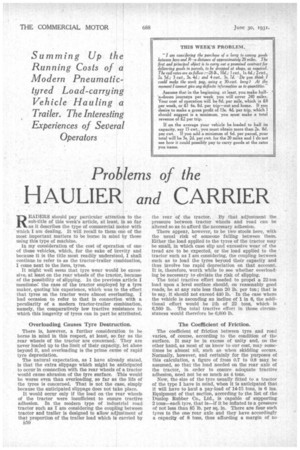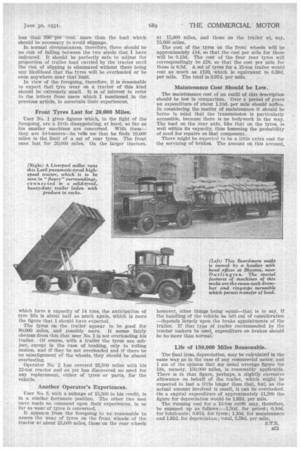Problems of the
Page 68

Page 69

If you've noticed an error in this article please click here to report it so we can fix it.
H AU LIER and CARRIER READERS should pay particular attention to the sub-title of this week's article, at least, in so far as it describes the type of commercial motor with which I am dealing. It will recall to them one of the most important matters to be borne in mind by those using this type of machine.
In my consideration of the cost of operation of one of these vehicles, which, for the sake of brevity and because it is the title most readily understood, I shall continue to refer to as tile tractor-trailer combination, I come next to the item, tyres.
It might well seem that tyre wear would be excessive, at least on the rear wheels of the tractor, because of the possibility of slipping. In the previous article I mentionee the case of the tractor employed by a tyre maker, quoting his experience, which was to the effect that tyres on the tractor were almost everlasting. I had occasion to refer to that in connection with a peculiarity of a modern tractor-trailer combination, namely, the comparatively low tractive resistance to which this longevity of tyres can in part be attributed.
Overloading Causes Tyre Destruction.
There is, however, a further consideration to be borne in mind in this respect, at least, so far as the rear wheels of the tractor are concerned. They are never loaded up to the limit of their capacity, let alone beyond it, and overloading is the prime cause of rapid tyre depreciation.
The natural expectation, as I have already stated. is that the extra slippage which might be anticipated to occur in connection with the rear wheels of a tractor would cause abrasion of the tyre surface. This would be worse even than overloading, so far as the life of the tyres is concerned. That is not the case, simply because the anticipated slippage does not take place.
It would occur only if the load on the rear wheels of the tractor were insufficient to ensure tractive adhesion. In the modern type of industrial road tractor such as I am considering the coupling between tractor and trailer is designed to allow adjustment of that proportion of the trailer load which Is carried by • 50 the rear of the tractor. By that adjustment the pressure between tractor wheels and road can be altered so as to afford the necessary adhesion.
There appear, however, to be two stools here, with the usual risk of someone falling between them. Either the load applied to the tyres of the tractor may be small, in which case slip and excessive wear of the tread are to be expected, or the load applied to the tractor such as I am considering, the coupling between such as to load the tyres beyond their capacity, and thus involve too rapid depreciation on that account. It is, therefore, worth while to see whether overloading be necessary to obviate the risk of slipping.
The total tractive effort needed to propel a 22-ton load upon a level surface should, on reasonably good roads, be at any rate less than 20 lb. per ton ; that is to say, it should not exceed 440 lb. In the case where the vehicle is ascending an incline of 1 in 8, the additional effort would be ith of 22 tons, which is 6,160 lb. The total tractive effort in those circumstances would therefore be 6,600 lb.
The Coefficient of Friction.
The coefficient of friction between tyre and road varies, of course, according to the condition of the surface. It may be in excess of unity and, on the other hand, as most of us know to our cost, may sometimes be almost nil, such as when skidding occurs. Normally, however, and certainly for the purposes of this calculation, a figure of from 0.7 to 0.8 may be assumed, so that the load needed on the rear axle of the tractor, in order to ensure adequate tractive adhesion, need not be so much as 4 tons.
Now, the size of the tyre usually fitted to a tractor of the type I have in mind, when it is anticipated that it will have to haul a pay-load of 14-15 tons, is 6 ins. Equipment of that section, according to the list of the Dunlop Rubber Co., Ltd., N capable of supporting 2 tons—each tyre, that is—if it be inflated to a pressure of not less than 85 lb. per sq. in. There are four such tyres to the one rear axle and they have accordingly a capacity of 8 tons, thus affording a margin of no less than -100-"t6r .cerit. more than the load which shOuld be necessary to avoid slippage.
In normal circumstances, therefore, there should be no risk of falling between the two stools that I have indicated. It should be perfectly safe to adjust the proportion of trailer load carried by the tractor until the risk of slipping is eliminated without there being any likelihood that the tyres will be overloaded or be even anywhere near that limit.
In view of the foregoing, therefore, it is reasonable to expect that tyre wear on a tractor of this kind should be extremely small. It is of interest to refer to the letters from users which I mentioned in the previous article, to ascertain their experiences.
Front Tyres Last for 20,000 Miles.
1..iser No. 1 gives figures which, in the light of the foregoing, are a little disappointing, at least, so far as his smaller machines are concerned. With them— they are 10-tonners—he tells me that he finds 10,000 miles is the limit of a set of rear tyres. The front ones last for 20,000 miles.. On the larger tractors, which have a capacity of 14 tons, the anticipation of tyre life is about half as much again, which is more the figure that I should have expected.
The tyres on the trailer appear to be good for 80,000 miles, and possibly more. It seems fairly obvious from this that user No. 1 is not overloading his trailer. Of course, with a trailer the tyres are subject, except in the ease of braking, only to rolling motion, and if they be not overloaded and if there be no misalignment of the wheels, they should be almost everlasting.
Operator No. 2 has covered 22,500 miles with his 12-ton tractor and as yet has discovered no need for any replacement, either of tyres or parts, for the vehicle.
Another Operator's Experiences.
User No 3, with a mileage of 15,500 to his credit, is in a similar fortunate position. The other two men have made no comment upon their experiences, in so far as wear of tyres is concerned.
It appears from the foregoing to be reasonable to assess the wear of tyres on the front wheels of the tractor at about 25,000 miles, those on the rear wheels at 15,000 miles, and those on the trailer at, say, 75,000 miles.
The cost of the tyres on the front wheels will be approximately £14, so that the cost per mile for those will be 0.13d. The cost of the four rear tyres will correspondingly be £28, so that the cost per mile for those is 0.5d. A set of tyres for a 15-ton trailer would cost as much as £120, which is equivalent to 0.39d. per mile. The total is 0.97d. per mile.
Maintenance Cost Should be Low.
The maintenance cost of an outfit of this description should be low in comparison. Over a period of years an expenditure of about 1.10d. per mile should suffice. In considering the matter of maintenance it should be borne in mind that the transmission is particularly accessible, because there is no bodywork in the way. The load on the rear axle, like that on the tyres, is well within its capacity, thus lessening the probability of need for repairs on that component..
There might be expected to be a little extra cost for the servicing of brakes. The amount on this account, however, other things teeing equal—that is to say, if the handling of the vehicle be left out of consideration —depends largely upon the brake appointments of the trailer. If that type of trailer recommended by the tractor makers be used, expenditure on brakes should be no more than normal:
Life of 150,000 Miles Reasonable.
The final item, depreciation, may be calculated in the same way as in the case of any commercial motor, and I am of the opinion that my usual average figure for life, namely, 150,000 miles, is reasonably applicable. There is in that figure, perhaps, a slightly excessive allowance on behalf of the trailer, which might he expected to last a little longer than that, but, as the actual amount involved is small, it can be overlooked. On a capital expenditure of approximately £1,200 the figure for depreciation would be 1.92d. per mile.
The running cost for a 15-ton outfit may, therefore, be summed up as follows :-1.50d. for petrol; 0.10d. for lubricants ; 0.97d. for tyres; 1.10d. for maintenance and 1.92d. for depreciation; total, 5.59d. per mile. S.T,R. B51




































































































